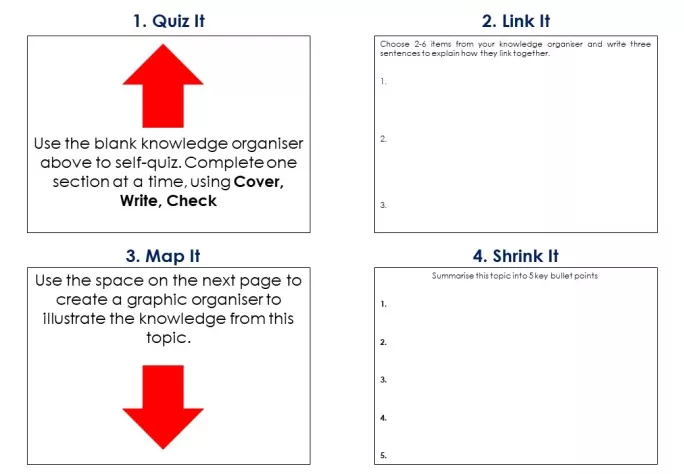- Home
- Teaching & Learning
- Secondary
- How to avoid the pitfalls of knowledge organisers
How to avoid the pitfalls of knowledge organisers

Knowledge organisers divide opinion: they take time to produce and critics argue that they lead to “inflexible knowledge”.
This is where students can only recognise the knowledge they need to use when they are questioned on it in one specific way. While Daniel Willingham argues that this type of knowledge provides an “essential foundation for expertise”, others say that, in isolation, it can lead to shallow learning and simplistic mental models.
However, when used effectively, knowledge organisers are invaluable.
We began to introduce knowledge organisers at my school three years ago, as part of a radical curriculum overhaul. We wanted students to have a clear view of everything they needed to learn and a tool to help them to know more and remember more. We were also developing our approach to retrieval practice, so knowledge organisers were a logical choice for our curriculum development.
More teaching and learning:
- Why creativity is just knowledge - and what that means for schools
- Daniel Willingham on memory, phonics and metacognition
- How one school revolutionised feedback in maths
The way we use knowledge organisers has evolved over time. After creating an evidence-informed template design, and training students to self-quiz in their own time using a very basic “look, cover, write, check” method, we realised that we were only scratching the surface. The approach wasn’t helping them to understand what it was they were now able to recall more fluently, and we began to see some of the signs of inflexible knowledge.
Getting the most out of knowledge organisers
A lot of reading, researching and conversations with colleagues from other schools helped us to crystallise a strategy to mitigate those issues.
So, how do we use knowledge organisers today?
We call the strategy “Quiz it, link it, map it, shrink it” (QILIMISI). Students are given independent learning booklets (ILBs) each half-term: these are produced collaboratively, in school, and contain every knowledge organiser students need for that half-term.

We explicitly teach students how to complete the QILIMISI activities through our metacognition tutor programme, supported by explanations in the ILBs, and video walkthroughs, which can be accessed on our website.
We encourage students to independently do 20 minutes of QILIMISI a day, as part of our home learning expectation. Students have some discretion in choosing the topic and activity they want to work on, but because the options are finite, over a half-term there is a natural variation.
The pages are in a repeating pattern of activities as follows:
Quiz it: Students fill in pre-identified parts of their blank knowledge organisers, from memory, and use the completed version to check and correct. We use “look, cover, write, check” for rehearsal (if students are encountering the knowledge for the first time) or just “cover, write, check” for retrieval practice (to ensure students are definitely recalling from memory). This is an adaptation from our original self-quizzing approach, which did not sufficiently discriminate between rehearsal and retrieval.
Link it: Students choose two to six items from their knowledge organisers and write three sentences to show how they link together. This could be any combination of a compare/contrast statement, a cause/effect statement or a support/refute statement. Students are also encouraged to explain these statements using “because…”. This helps them to develop their understanding and make more sophisticated connections in their schema.
Map it: Students choose an appropriate way to represent the knowledge from a section or topic with a graphic organiser. They choose from an initial selection of four but can then diversify as they progress/become more skilled. Examples include a mind-map to categorise information or a fishbone diagram to show cause and effect.
Shrink it: Students are taught to summarise effectively as part of the work we do around the whole-school literacy strategy. They employ this technique to write a summary of the topic, illustrating their understanding.

We launched this approach in June last year and so far we have seen a real improvement in both the amount and the quality of students’ independent learning. Feedback tells us that knowledge organisers are highly valued by staff, students, and their families.
Of course, this strategy, in itself, does not entirely negate the problems of inflexible knowledge, but as part of a wider curriculum, which incorporates a broad range of different encounters with that knowledge, we’re getting closer.
As with any strategy, success comes down to how you adapt and refine it to suit your own context. But if you would like to do something like this in your own school, I’d recommend designing a knowledge organiser template and sticking to it to reduce cognitive load for students and staff. Before the roll-out, decide how you want students to use their knowledge organisers, and then teach this explicitly and repeatedly so it becomes routine.
You should also carefully consider how you will support students’ understanding, and plan a variety of other encounters with the knowledge that require students to think hard. And lastly, I’d urge you to make knowledge organisers high-profile, and regularly refer to them in lessons.
At the end of the day, there is no point having them unless they are an integral part of your curriculum.
Kelly Tatlock is an assistant headteacher, teaching and learning, in West Yorkshire
You need a Tes subscription to read this article
Subscribe now to read this article and get other subscriber-only content:
- Unlimited access to all Tes magazine content
- Exclusive subscriber-only stories
- Award-winning email newsletters
Already a subscriber? Log in
You need a subscription to read this article
Subscribe now to read this article and get other subscriber-only content, including:
- Unlimited access to all Tes magazine content
- Exclusive subscriber-only stories
- Award-winning email newsletters
topics in this article



